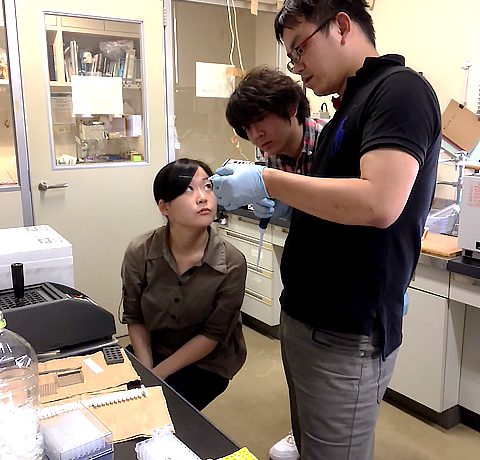Assistant Professor at Faculty of Engineering, Kumamoto University
(Program-Specific Research Associate at iCeMS Motonari Uesugi Lab until March 2017)
Yousuke Katsuda
Yousuke Katsuda
DNA contains genetic information necessary for constructing RNA, and the RNA acts as a messenger of the information to make functional proteins in cells. Dr. Yousuke Katsuda and his team found a unique compound named RGB-1 that has high-selectivity for RNA G-quadruplex. His group also reported a new methodology to identify RNA G-quadruplexes in cells.

Please share with us the significance of your manuscript in terms of its research achievements, impact, or uniqueness.
It has been understood that RNA plays the role of a genetic information transporter. In recent years, it has become clearer that RNA has an additional function that regulates biological reactions by forming a non-canonical structure. Understanding of the whole structures formed with RNA will unlock the mystery of biological phenomena.
The study of RNA G-quadruplex in in vitro experiments reveals that this structure regulates “translation reaction.” Yet, the location of RNA G-quadruplex in cells has remained unclear.
Our group tried to identify a hit compound that has affinity for RNA G-quadruplex structures by screening our chemical library. We then hypothesized that the location of RNA G-quadruplex might be easily spotted with this compound being used as “fishing bait.”
An appealing point of our study is the unique application of the “fishing bait” to catch the RNA G-quadruplex in cells.
What would you say is the most exciting or “I made it!” moment during this research project?
I was very happy when I found a hit compound that binds to RNA G-quadruplex structures out of the chemical library of 70,000 compounds. And I was more than thrilled at the very moment when we clarified the high selectivity of RGB-1 for RNA G-quadruplexes, realizing the enormous potential of this compound.
Please tell us about the biggest challenge or problem you experienced while conducting your research. How did you overcome it?
Throughout this project, there was no practical hurdles that we couldn’t overcome, but looking back on the days and years spent for the project, I would say all the steps and processes taken were full of challenges, and there was a mountain of problems to be solved. All these matters were settled by having intensive discussions with Dr. Shin-ichi Sato, Prof. Motonari Uesugi, and all those who were involved in this project.
Would you consider this work to be a turning point in your overall research direction? If so, how has your research direction changed as a result of this work?
In a sense, I can proudly say that this project has become my turning point that determines my research direction, because the project let me realize that I am strongly interested in the research field of nucleic acid chemistry. The direction where my future research is shaped into in the next five to ten years will answer the question of whether this project is de facto my life-changing turning point or not. For the time being, I will try my best to keep the level of research as high as that of the iCeMS fellows.
Please describe the current situation of your career. What is your current position? How has the knowledge and experience gained at iCeMS influencing your career?
Currently, I work as an assistant professor for Department of Applied Chemistry and Biochemistry, Kumamoto University. This department is managed under the same research concept as the iCeMS’s During the 8 years with the iCeMS, I have learned the importance of being open for discussion with other researchers, thinking critically, and acting with flexibility.
Although I am a rookie in this department, I am willing to extend my experience from iCeMS to researchers and collaborators at Kumamoto University.
Finally, please give a message or advice to young iCeMS researchers.
iCeMS consists of scientists from many different fields. To have my paper published, Dr. Morimura, who was a member of IT Strategy Office in iCeMS, has helped me with his expertise and his name is listed as a co-author. You may think that people who are specialized in a completely different research field than yours would not be so important for your research project. A head-to-head discussion with such seemingly irreverent people, however, may lead to a new collaboration project.
What I can say with my experience is that iCeMS young researchers should meet and talk with a lot of iCeMS scientists of integrated research fields, and feel the diversity and possibility of cutting-edge science.
*All the information on this page, including the researcher’s affiliation, is current at the time of the interview.
Paper information
A Small Molecule That Represses Translation of G-Quadruplex-Containing mRNA
Yousuke Katsuda, Shin-ichi Sato, Lisa Asano, Yoshitaka Morimura, Tomoyuki Furuta, Hiroshi Sugiyama,Masaki Hagihara and Motonari Uesugi
Journal of the American Chemical Society
Published: June 2016
DOI: 10.1021/jacs.6b04506